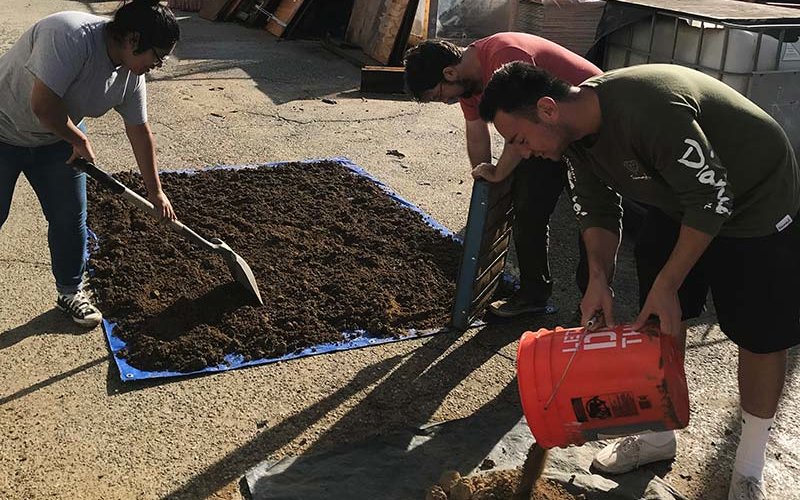
Civil engineering student Anthony Gonzalez is studying the impacts to soil following rainfall in Southern California areas reduced to ashes by wildfires — and the risks of barren slopes and hillsides in triggering destructive and deadly landslides, mudslides and debris flows.
“The focus of this research is to try to understand how much water it will take for a mudslide to occur in different scenarios,” Gonzalez said. “We’re researching the impacts to different soil conditions, including plain soil, soil that contains vegetation, such as plants and grass, and soil with fire ash. From this data, we’re able to analyze slope stability, material strength, slope change, water content in soil and vegetation.”
Gonzalez, a junior, is among student researchers working under the guidance of Cal State Fullerton landslide and mudslide faculty expert Binod Tiwari. He and his research partners, undergraduate Jhayna Leon and graduate student Rupert Barnett, are developing small-scale slope models in the laboratory for the study. The students will apply different amounts of rainfall on the slopes to evaluate the effects of rainfall intensity and duration in setting off mudslides.
“This research is important because it will give us a better understanding of where and when mudslides are most likely to develop. We hope our findings help reduce or prevent the amount of property damage that occurs,” Gonzalez said. “It’s relevant to California because of the high frequency of wildfires occurring here.”
Tiwari, professor of civil and environmental engineering and CSUF’s 2017 Outstanding Professor, noted that the risk of mudslides following rainfall drops dramatically on slopes that have vegetation. But so far, their research shows that on fire-ravaged slopes, a significantly lesser amount of rainfall can cause mudslides.
Since wildfires change the composition of the soil, making it less porous to allow rainwater to seep through the ground, there also is a greater likelihood of surface water runoff and flooding following an intense rainfall, added Tiwari. He just returned from a conference of the International Consortium on Landslides, where he serves as vice president, and presented his research at the International Program on Landslides, held in Kyoto, Japan.
Last summer, Tiwari and graduate student Basil Habhab collected rainfall data in the Montecito/Santa Barbara area, which was devastated by wildfire in December 2017, and resulted in disastrous mudflows and debris flows.
“What we found was that the rainfall in Montecito last year was much less than what the area had in several years,” explained Tiwari, adding the researchers are continuing to perform modeling experiments in the lab.
“But it only took a small amount of rainfall to trigger the catastrophic mudslides and debris flows that occurred due to the loss of vegetation cover and the accumulation of ash on the ground surface.”
Rainfall intensity of half an inch per hour for just 30 minutes is all it takes to trigger a mudslide on freshly burnt slopes, Tiwari continued, compared to four hours of intense rainfall in areas with vegetation cover.
Tiwari plans to expand their research efforts in spring to include rainfall data and soil properties from this fall’s Southern California Woolsey Fire and Northern California Camp Fire.
For Gonzalez, working on this research project has taught him valuable research and teamwork skills that he plans to use in his future engineering career.
“This is an opportunity for me to gain hands-on experience by taking what I’m learning about soil mechanics in the classroom and in the lab, and applying it to real-world situations,” he said.